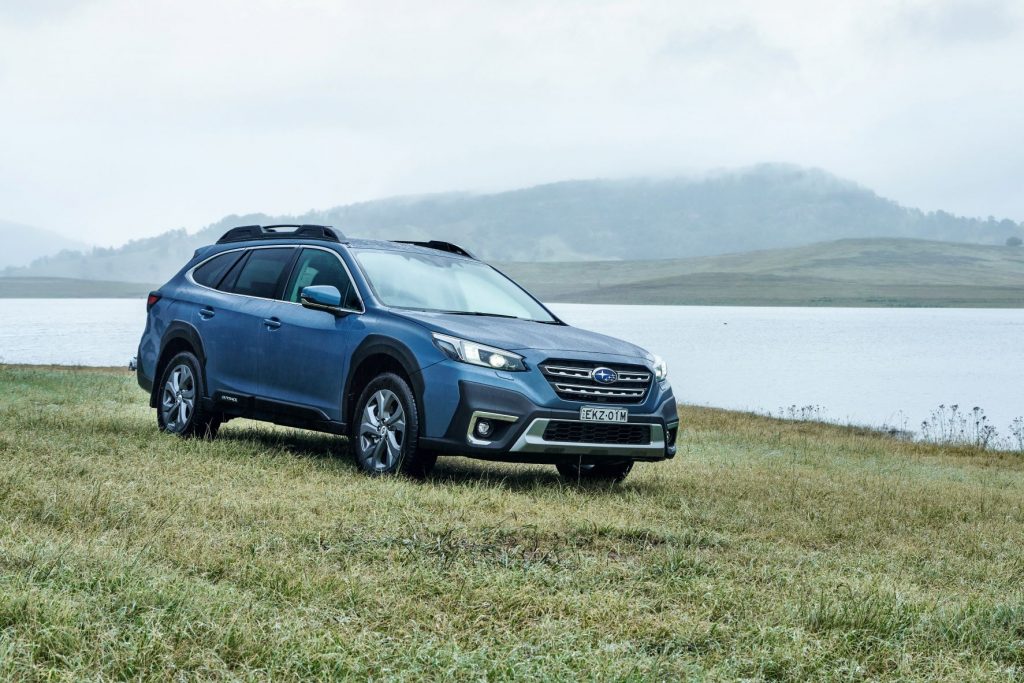Chris Riley tests the 2022 Subaru Outback AWD Touring with pricing, specs, ride and handling, safety, verdict and everything the over-50 driver needs to know.
Summary: High levels of safety and the advantages of an SUV without the unnecessary size combine to make the Subaru Outback a compelling package … unless you need to tow more than 2000kg or accommodate seven.
2022 Subaru Outback AWD Touring
Pricing: $47,790 (plus on road costs). Outback AWD from $39,990.
Warranty: Five-years, unlimited km
Safety: 5-star ANCAP
Engine: 2.5-litre direct injection horizontally opposed Boxer engine
Power: 138kW at 5800rpm
Torque: 245Nm at 3600-4600rpm
Transmission: eight-speed CVT
Drive: part time all-wheel drive
Body: 4870mm (long); 1875mm (wide); 1675mm (high)
Ground clearance: 213mm
Weight: 1661kg
Towing capacity: 2000kg
Wheels: 18-inch alloy
Tyres: 225/60 R18
Spare wheel: full size
Turning circle: 11.0mm
Fuel tank: 63 litres
Thirst: 7.3L/100km (combined, 91 RON or higher)
Consumption on test: 9.3L/100km
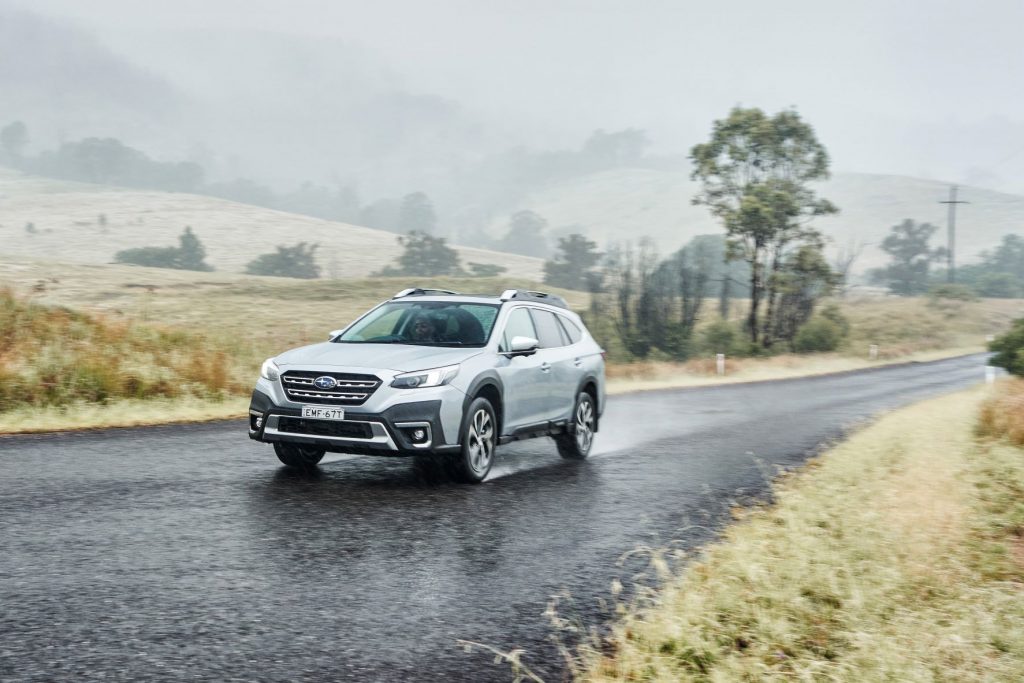
[review]
With Liberty’s departure, Outback is now flagship of the Subaru range – but not the most expensive.
That dubious honour goes to the hard-edged, high-performance version of the WRX sporty – the STI spec.R.
But I know which one I’d rather have. My wife reckons the latest Outback is a corker too.
About the only thing missing is a third row of seats.
In fact, there’s no 7-seater in the entire Subaru range which is a bit strange – not since the Tribeca people mover in 2013.
We drove the bare bones Outback a few weeks back.
This time we’re enjoying a tilt in the top of the range Touring model.
Which begs the question: is it worth an extra $8140?
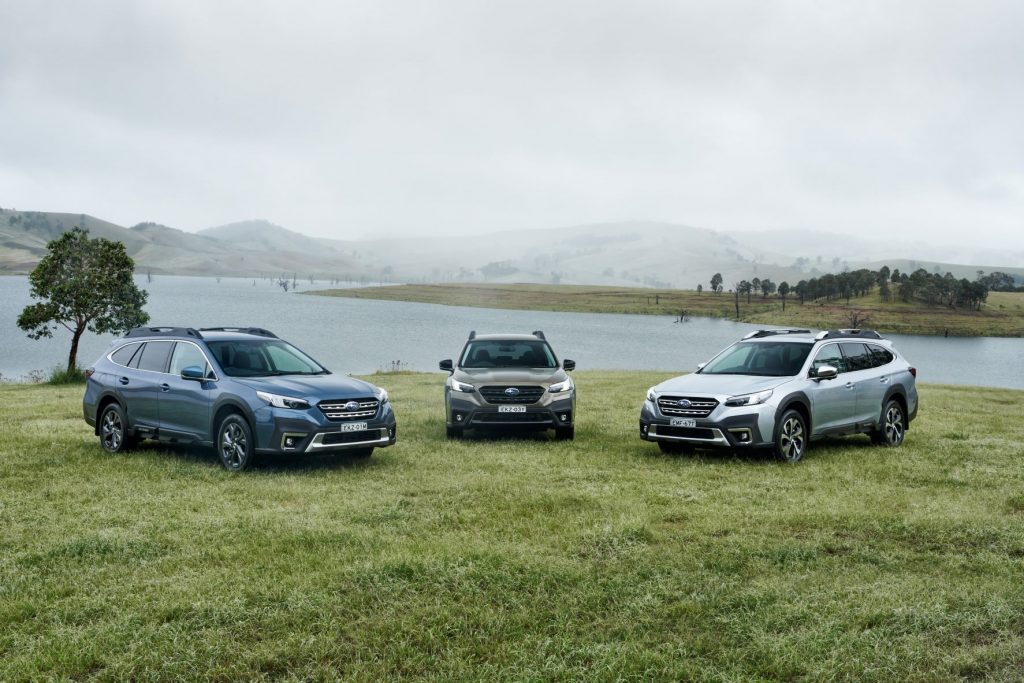
What’s it cost?
More like a wagon than high-riding SUV, Outback has continued to evolve over the years, getting better and better with each outing.
There are three grades and even the entry Outback is well equipped, priced from $39,990 plus on-roads.
Next up is the Sport priced from $44,490, followed by top of the range Touring from $47,790 – or an advertised $52,928 driveaway.
They all get the same engine, transmission and wheels.
Subaru has done the right thing too and standardised safety systems across the line-up, apart from a side view monitor for the Sport and Touring grades.
The Touring model ups the ante with minor cosmetic differences, leather instead of cloth trim, dual zone climate air with rear air vents, rear privacy glass and auto power up for all windows.
There’s also 18-inch alloys, push-button start, auto lights and wipers, auto dimming mirror, auto high beam, rear park sensors, self-levelling, daytime LEDs, steering-responsive LED headlights and adaptive cruise control.
Other differences include a sunroof, power tailgate, heated steering wheel, heated seats front and back, power adjustment for both front seats, with dual memory for the driver’s seat, auto dipping side mirror, and the icing on the cake – 9-speaker Harman Kardon sound with subwoofer and amplifier.
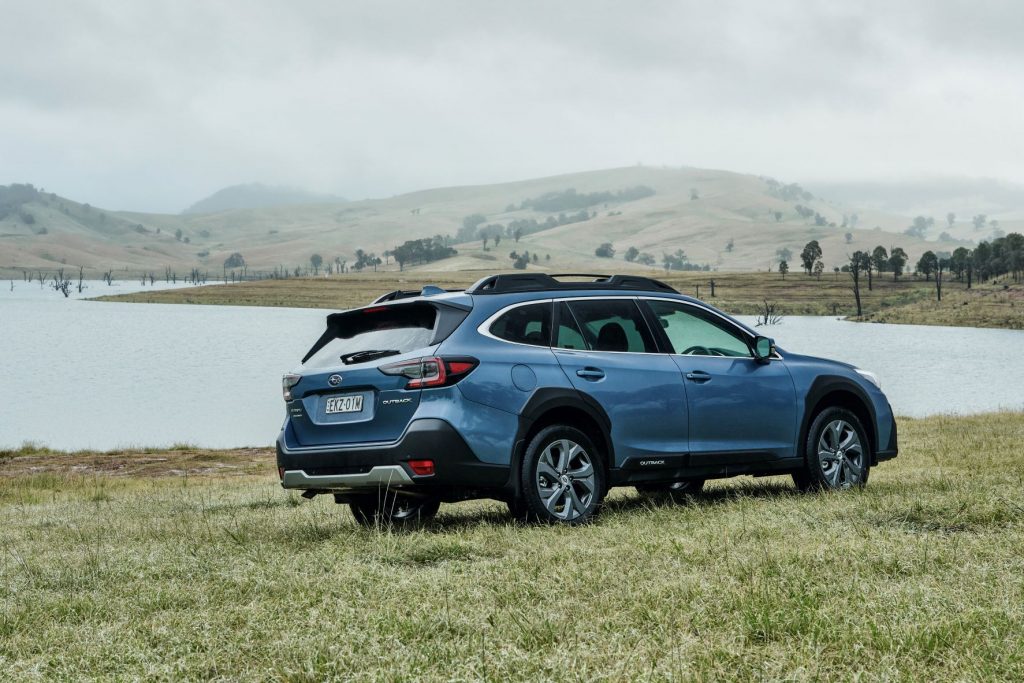
Without a third row of seats, the cabin is spacious and comfortable, with leather and heating front and back, not to mention a heated steering wheel – but alas no cooling for the front seats.
The big touchscreen is impressive, and this model does come with built-in satellite navigation.
You can also hook up your phone to navigate, but as seems to be the norm, our phone would not connect to Android Auto at first and when it did, the system refused to cooperate until the vehicle came to a stop.
The big portrait style screen can be configured to show one large portrait-shaped huge map, or tiers of information – map at the top, audio and air controls below.
The actual driver’s instrument cluster is old school with two analogue dials separated by a small info panel where speed can be displayed digitally and the speed limit is shown.
We’re big fans of the large, physical blind spot warning lights that never fail to capture attention.
There’s a 9-speaker Harman Kardon sound system.
Don’t know about you, but I reckon you can’t spend too much on car audio.
The car is a place you spend a lot of time and a large percentage of this is spent listening to music.
The huge 11.6-inch portrait style touchscreen brings satellite navigation and a CD player this time around, along with DAB+ digital radio, Apple Carplay and Android Auto, with 2 x 12v and 2 x USB ports.
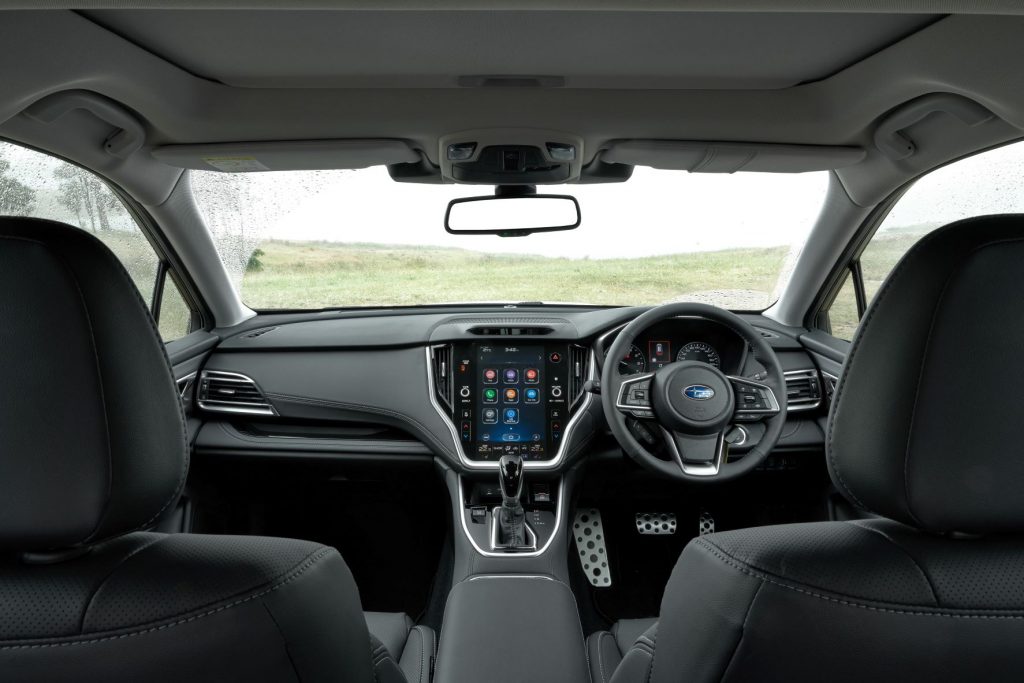
Safety includes eight airbags, a reverse camera and the latest generation EyeSight Driver Assist system, with Lane Centring Function and Autonomous Emergency Steering.
There’s also Emergency Lane Keep Assist, and Lane Departure Warning with steering wheel vibration.
Lane Departure Prevention and Pre-Collision Braking System, with expanded support for collision avoidance at intersections are also fitted, along with Speed Sign Recognition with Intelligent Speed Limiter,
Vision Assist includes Blind Spot Monitor (BSM), Lane Change Assist (LCA), Rear Cross Traffic Alert (RCTA), Reverse Automatic Braking (RAB), and EyeSight Assist Monitor.
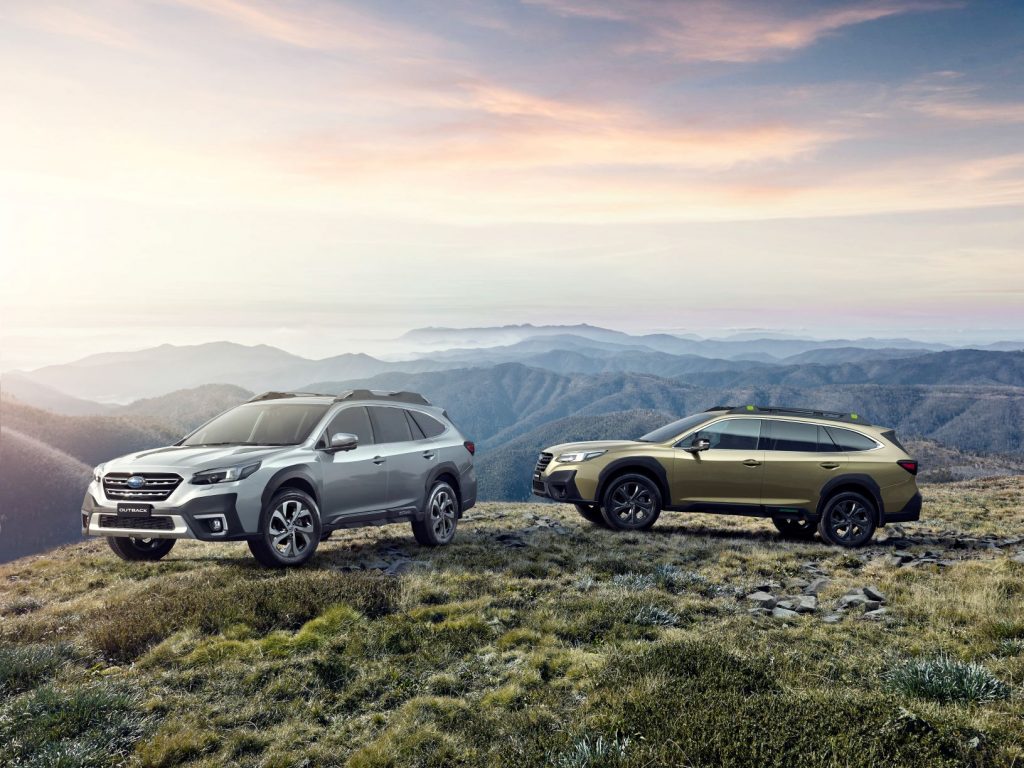
What’s it go like?
The four-cylinder direct injection boxer layout delivers 138kW of power and 245Nm of torque, the latter from 3400-4600 rpm – about seven percent more power and four percent more torque than before.
It’s paired with a CVT-style continuously variable auto, with a greater spread of ratios for improved take-off and better fuel economy.
The transmission comes with paddle shifts and 8-speed manual mode, as well as sport and intelligent drive modes.
As mentioned previously, all grades are powered by the same 2.5-litre naturally aspirated four-cylinder petrol engine.
The diesel has gone to heaven and there’s no word yet on a hybrid, which has already found its way into XV and Forester.
Subaru claims the flat four is 90 percent new and like the BRZ, it seems to be better than the figures suggest.
Drive is to all four wheels, but only part of the time.
Although described as Symmetrical all-wheel drive, it is in fact an active split system with torque distributed between front and rear wheels as required.
In short, it remains front-wheel drive most of the time.
Dual function X-MODE offers set-and-forget throttle control in mud, snow and steep unsealed surfaces, with 213mm of ground clearance, and active torque vectoring that brakes individual wheels to maintain control during cornering.
Auto Stop-Start now incorporates “Change of Mind Control” which as its name suggests, restarts the engine within 0.2 of a second – if you change your mind.
Suspension is Mac strut at front and double wishbones at the back and it rides on 18-inch wheels with 225/60 series rubber, with a full-size spare.
Shame about the diesel which offered 350Nm of torque, but it is what it is and for the most part, performance is fine.
It’s only when you become demanding and punch the accelerator, that you’re reminded it’s a four – and a naturally aspirated one at that.
Subaru has access to turbocharged units and very good ones, which have the potential to replace low end torque.
So, why it didn’t opt for one of these is mystifying.
Bear in mind too, that maximum torque, in this case 245Nm, is produced from 3400-4600 revs – which means it needs a few revs to get going.
In its quest for torque, the CVT transmission makes the car sound tinny and raucous, with the zoominess that makes these style trannies so objectionable.
At other times, in fact most of the time, the drive experience is just right, with a cabin that is quiet and ride that is super smooth.
With a 63-litre tank, it takes standard 91 unleaded and like the previous model is rated at 7.3L/100km.
We were getting 9.3L/100km (the base model returned 8.1L).
Also, it can tow a 2000kg braked load, with a maximum 200kg on the towball (it was previously rated at 1500kg).
What we like
- Quiet
- Comfortable
- Satellite navigation
- Smooth on the road
- Station wagon format
- Ease of entry and exit
- Large luggage capacity
What we don’t like
- No hybrid option yet
- Only option 2.5-litre petrol engine
- Can be really noisy and obnoxious under load
- No cooling for front seats
Things over-50s need to know
The Subaru Outback is the go-to choice for many older drivers.
Subaru’s strong emphasis on safety is major drawcard and they have a reputation for being robust, which might explain why people keep their Soobies so long.
The station wagon format is also familiar, the ride height is just right for ease of entry and exit and because Subaru does not try to cram in a third row of seats, the interior and seating is spacious and comfortable.
It’s a shame there’s no diesel, but in recent years Subaru has managed to pare back fuel consumption and as long as you have a light foot, the figures are more than reasonable.
Towing at 2000kg however remains modest.
Is the extra $8000 grand for the Touring worth it?
Strictly speaking, I don’t think so, at least not when you put it that way.
But at $52,928 driveaway, with this level of safety, built-in sat nav and premium Harman Kardon sound, there’s absolutely no more to spend and that makes the Outback Touring model worth every cent.
RATINGS (out of 10)
Looks – 7.5
Performance – 7.0
Safety – 8.5
Thirst – 7.0
Practicality – 8
Comfort – 8
Tech – 8.5
Value – 8.5
Overall – 7.9
This review was prepared by Chris Riley and first appeared on cars4starters, https://cars4starters.com.au/
seniordriveraus comments
Subaru’s decision to not include a third row of seats in the Outlander may cost it some sales, but considering the overall dimensions, is understandable.
The Outback has always been a usable station wagon with SUV capability, rather than the other way around.
We applaud the inclusion of the same level of safety in all three grades, rather than making some safety features optional in the lower grades. It may mean a slightly higher entry price, but it’s the right thing to do.
Chris points out – once again! – his difficulties connecting his phone to Android Auto. Mostly, these systems are reliable, but extremely frustrating when they don’t cooperate. Of course, for most users (unlike motoring journalists), it’s a matter of pairing your phone once and then never having to think about it again.
The absence of a diesel will concern some buyers, and there’s no word yet about a hybrid version. A diesel variant makes more sense for towing, and to be honest, the 2000kg braked towing rating for the petrol-engine Outback will be marginal for many people. We’d suggest you keep in mind the torque figure of 245kW and the relatively high revs needed to access it if your plans include attaching a van behind.
The Outback’s fuel tank capacity of 63 litres may also be on the small side if you’re planning to go towing. Using the quoted fuel consumption of 7.3L/100km, that translates to a theoretical range of 860km. However, Chris only managed 9.3L/100km, a theoretical range of just under 700km. And that will be seriously reduced if you have a van behind you.

